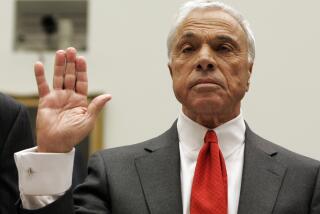Investors look beyond loss at Countrywide
- Share via
Countrywide Financial Corp. reported its first loss in 25 years Friday -- a sobering $1.2 billion -- and Wall Street cheered, sending the mortgage lender’s shares up more than 32% in heavy trading.
Although the loss was bigger than analysts had expected, investors appeared to be encouraged by Countrywide’s assertion that the third quarter ended Sept. 30 was “the trough” of its troubles. The Calabasas-based lender said profit would resume this quarter and continue through 2008.
“With our focus and our mission, we have a much better chance of success than any other player in the mortgage space,” Countrywide Chairman Angelo Mozilo told analysts.
Mozilo, who ramped up his stock sales before Countrywide shares plunged this year, said he was cooperating with federal regulators examining his trading. He asserted that he never made any trading decisions based on information that wasn’t publicly known.
Countrywide shares, which Thursday had closed at a four-year low of $13.07, soared $4.23, or 32.4%, to $17.30. Trading volume was massive, with 123 million shares changing hands.
Analysts said the buying Friday included “short sellers” who had borrowed the stock and sold it, betting it would decline. Some of those traders were buying shares to close out their positions and take their profits.
“Short covering was huge,” said Frederick Cannon, a Keefe, Bruyette & Woods analyst who has been critical of Countrywide.
The beaten-down shares of other mortgage lenders also rallied. Washington Mutual jumped $1.28 to $28.58, Downey Financial gained $2.29 to $42.27 and FirstFed Financial was up $1.85 to $44.20.
Countrywide’s $1.2-billion loss, or $2.85 a share, contrasted with a year-earlier profit of $648 million, or $1.03 a share. It included gigantic write-offs for dud loans, losses on mortgage sales and markdowns on the value of riskier loans Countrywide had intended to sell but which no one would buy. The accounting adjustments were so extensive that revenue, $2.8 billion in the third quarter of 2006, was recorded at a negative $50 million.
But the nation’s largest home lender said its plan to shun sub-prime lending to borrowers with scuffed credit, along with other higher-risk loans, was shaping up successfully. The strategy will cost the jobs of as many as 12,000 employees, about 20% of Countrywide’s workforce.
By focusing on plain-vanilla mortgages, safer and more salable than the risky loans that helped fuel the housing boom, Countrywide has “taken the steps we believe are necessary to address the current challenging market,” Mozilo said.
The company endured a barrage of bad news last week, including demands by union pension funds for Mozilo’s ouster and the resignation of board member Henry Cisneros, the third director to depart in less than a year. A Lehman Bros. analyst downgraded Countrywide’s stock, predicting the mortgage industry would continue to bleed losses at least through 2010.
But when the company’s earnings report was released two hours before the markets opened, investors liked what they saw. Countrywide, which last summer had nearly run out of money to lend, had $5 billion in cash on its balance sheet. The company, which had to tap $11.5 billion in emergency credit in August after cash ran short, said it had since lined up $18 billion of “highly reliable” funds.
Countrywide, having endured the August deep freeze in the capital markets, now would go forward as “the only survivor of any major mortgage company in the country,” Mozilo said. “With the quality of the management team, the focus that we have, the mission that we’re on, I think we have a much better chance of success than any other player in the mortgage space today.”
Merrill Lynch & Co. analyst Kenneth Bruce, who stirred up the tsunami of withdrawals from Countrywide Bank in August by suggesting the lender might go bankrupt, upgraded the company Friday from “sell” to “neutral.”
Countywide’s loss -- the first quarterly deficit it had reported in 25 years -- came as the lender tried to engineer abrupt changes in strategy.
The company funded $96 billion in loans during the quarter, down from $118 billion a year earlier, as it shifted to more traditional loans that the government-sponsored loan buyers, Freddie Mac and Fannie Mae, will purchase.
It beefed up loan-loss reserves to offset rising delinquencies and defaults, especially in the sub-prime market for borrowers with poor credit scores or overtaxed finances. The third-quarter reserve for bad loans was $934 million, up from $38 million a year earlier.
The company also recorded $1 billion in charges for losses on loan sales and write-downs on mortgages and mortgage securities for which the market has evaporated. It said it had moved about $12 billion in loans it could not sell onto its own books as investments after their write-down.
As delinquencies and defaults soared on sub-prime mortgages this year, battering investors around the globe who had purchased securities backed by the loans, Countrywide and other lenders found they could no longer count on Wall Street to provide them with funds to loan and to buy the resulting mortgages.
Countrywide is compensating by accelerating growth at its savings and loan association.
--
Times staff writer Tom Petruno contributed to this report.
More to Read
Inside the business of entertainment
The Wide Shot brings you news, analysis and insights on everything from streaming wars to production — and what it all means for the future.
You may occasionally receive promotional content from the Los Angeles Times.











